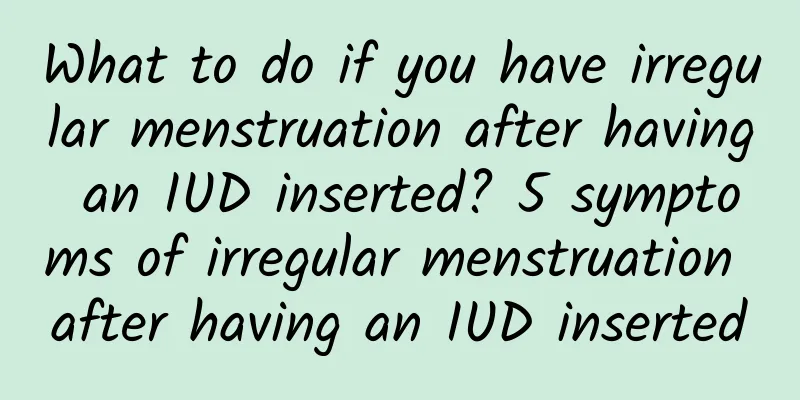What to do if you have irregular menstruation after having an IUD inserted? 5 symptoms of irregular menstruation after having an IUD inserted

|
Neuroendocrine dysfunction, organic diseases or medications can cause irregular menstruation. Some women find that their menstruation is not as regular as before and the amount is different. So can an IUD cause irregular menstruation? Will IUD insertion cause irregular menstruation? The IUD itself is a minor operation. The body needs some time to adapt to the sudden placement of a foreign body in the uterus. The uterus may strengthen its contraction to expel the foreign body, and then some mothers may not feel its presence. Some mothers may experience symptoms such as back pain, vaginal bleeding, and irregular menstruation, but these adverse reactions will disappear automatically after a period of time. Bleeding after IUD insertion VS Menstruation after IUD insertion Bleeding after IUD insertion: There will be a small amount of bleeding within 3 days after IUD insertion, which is less than the menstrual flow and generally does not exceed 7 days. However, if the menstrual bleeding after IUD insertion lasts for half a month and the blood is red, it is necessary to consider that the IUD may over-stimulate the endometrium. At this time, you must go to a regular professional hospital for examination in time. Menstruation after IUD insertion: Women usually menstruate one month later, but this is not absolute and varies from person to person. It is normal for a few women to have delayed menstruation after IUD insertion. Irregular menstruation: This is one of the most common symptoms of women after IUD insertion. Irregular menstruation after IUD insertion often causes menorrhagia, prolonged menstruation, irregular menstrual bleeding, etc. This happens about half a year after IUD insertion and will improve as the placement time goes by. However, irregular menstruation is not the reason for IUD insertion, and you cannot judge it yourself. If menstruation is delayed for more than ten days, it is recommended to go to a regular hospital's gynecology department for relevant examinations, take correct measures under the doctor's guidance, and deal with it in a timely manner. The main reasons for irregular menstruation after IUD insertion: 1. Intrauterine contraceptive devices can activate fibrinolytic enzymes in endometrial tissue, which is not conducive to local coagulation function. Therefore, the enhancement of fibrinolytic enzyme activity may be the cause of increased menstruation and irregular vaginal bleeding after IUD placement. 2. An IUD of inappropriate size may compress the endometrium, causing local tissue necrosis and inflammatory response, leading to menstrual irregularities. The best time to choose an IUD for caring for an elderly friend The best time to insert the IUD is 3-7 days after the menstrual period ends. However, the IUD is not suitable for the following three situations. 1. People with heavy menstruation are generally not recommended to use contraceptive rings, because contraceptive rings will increase the activity of fibrinolytic enzymes. Increasing the activity of fibrinolytic enzymes will lead to fibrinolysis, destroy the blood coagulation function, and thus increase the amount of bleeding. 2. Irregular menstruation is often a symptom of various gynecological diseases. If you experience this symptom, do not have an IUD inserted. Wait until your body has recovered before having one. 3. Women who have symptoms such as irregular menstrual cycles and dysmenorrhea are not suitable for IUD insertion. At this time, barrier contraceptive methods can be used: including condoms, diaphragms, and cervical caps, also known as tool contraception, which play a contraceptive role by isolating sperm and eggs. Condoms should be the most commonly used and safest method, but they can also prevent infectious diseases. Precautions for women after having an IUD inserted 1. After placement, a small amount of vaginal bleeding and lower abdominal discomfort may occur, most of which will disappear on their own; the main complication of IUD placement is bleeding. The main symptoms are menorrhagia, prolonged menstruation, irregular menstrual bleeding, etc. Generally speaking, there is always a small amount of bleeding after the ring is placed, but it does not exceed one week. If the bleeding exceeds one week, or the amount of bleeding exceeds the amount of menstruation, it is an abnormal reaction. If bleeding, abdominal pain, fever, you should go to a medical unit for diagnosis and treatment; 2. Do not do too much physical labor within a week; stay in bed for three days. Excessive exertion can easily cause bleeding and inflammation. 3. Bathing and sexual intercourse are prohibited within half a month after the operation. 4. Within 3 months after placement, pay attention to less activity and avoid heavy physical activities, including long-term walking, long-term sitting, standing, etc. If the menstrual volume may increase, pay attention to whether the IUD falls off during menstruation, and do not have sex or take a bath if there is vaginal bleeding. 5. If any of the following conditions occur, go to the hospital for diagnosis and treatment immediately: severe abdominal pain, fever, pelvic pain, increased vaginal discharge, irregular menstruation or pregnancy, IUD shedding, pain during sexual intercourse, excessive or irregular bleeding or bleeding, etc. |
Recommend
What are the precautions for preventing vaginitis?
What are the main aspects of vaginitis? Many pati...
Simple face-lift secrets to save difficult face-lifts
Ladies who want to slim down their faces, look he...
Brief analysis of two common symptoms of cervical erosion
Cervical erosion is a disease that often occurs i...
Super strong! Tips to get rid of back fat in 4 days
The fat on my arms and waist...I wish all the fat...
What does an egg-sized uterine fibroid look like? Is an egg-sized uterine fibroid serious?
What does an egg-sized uterine fibroid look like?...
Physiological and pathological differences in pelvic effusion
The difference between physiological and patholog...
How much does the second stage treatment of cervical warts cost?
In today's society, "it's difficult ...
What are the best ways to prevent endometrial tuberculosis?
There are many types of tuberculosis among gyneco...
Warning: Common causes of primary dysmenorrhea
Primary dysmenorrhea is a type of dysmenorrhea wi...
Developing good habits is the key to preventing vaginitis
In modern society, changes in social and living e...
What are the dangers of menopause?
The harm of premature menopause to women. Due to ...
How to pay attention to diet after abortion
Abortion refers to the termination of pregnancy b...
What are the causes of acute adnexitis?
Adnexitis is a disease that many women suffer fro...
What causes vulvar itching?
Vulvar pruritus is one of the diseases with a rel...
How should pregnant women deal with vulvar leukoplakia correctly
What should pregnant women do if they suffer from...









